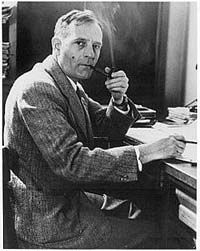
| Born: Nov 20, 1889 in Marshfield, Missouri, U.S. |
| Died: Sep 28, 1953 (at age 63) in San Marino, California |
| Nationality: American |
| Famous For: Hubble sequence |
| Awards: Legion of Merit 1946, Gold Medal of the Royal Astronomical Society 1940, Franklin Medal 1939, Bruce Medal 1938 |
Edwin Hubble was an American astronomer who played a vital role in the establishment of extragalactic astronomy. He is regarded as one of the valuable observational cosmologists of the 20th century. He is specifically known for illustrating that recessional velocity in a galaxy increases with the distance from the earth, which implies that the universe is constantly expanding.
Edwin Hubble’s Early Life
Edwin Hubble was born in 1889. During his early years, he was noted more for his prowess in athletics than in his intellectual capabilities. He was a gifted athlete who played football, basketball, baseball and track. In fact, he ran track in both college and high school. He went to school at the University of Chicago and concentrated mainly on math, philosophy, and astronomy. These earned him a bachelor’s degree in science in 1910.
He was married to one wife, Grace Hubble.
Hubble’s Career
Hubble’s father wanted him to study law. As a result, Edwin studied law at the University of Chicago and then later at Oxford. Since he did not have a passion for law, he began teaching physics, math, and Spanish at the New Albany High School after his father died. At the age of 25, he gave up his teaching career and became a professional astronomer.
Hubble’s Contribution to Astronomy
In 1923, Hubble trained a Hooker telescope on a patch of the sky by the name of Andromeda Nebula. He discovered that it had stars similar to the ones in the galaxy, only dimmer. From the discovery, Hubble deduced that Andromeda Nebula was not a star nearby but rather an entire galaxy, which has subsequently been named the Andromeda Galaxy.
Hubble went on with his discoveries and by the end of those ten years, he found galaxies to compare with each other. He made a system that classified galaxies into spirals, barred spirals, and elliptical. This system is now known as the Hubble tuning fork diagram and it is still used today, but in an evolved form.
Hubble’s major discovery was when he studied spectra of 46 galaxies. He studied the Doppler velocities of the galaxies that were similar to the Milky Way. He discovered that the farther apart the galaxies are, the faster they move apart from each other.
Hubble also wrote two books – The Observational Approach to Cosmology and The Realm of the Nebulae.
The Hubble Telescope
Hubble has a telescope named after him: the Hubble Space Telescope. It was launched in 1990 with a main goal of pinning down the Hubble constant. The telescope helped discover that the universe is not only expanding, but that the expansion is accelerating as well.
Hubble’s Death
After his long career at Mt. Wilson Observatory, Hubble died in 1953 following a heart attack in 1949 and a blood clot in his brain four years later. There was no funeral for him and his wife did not reveal his burial site.